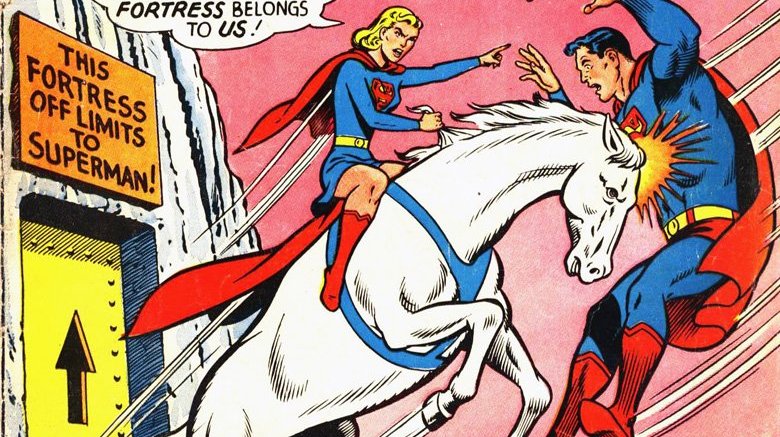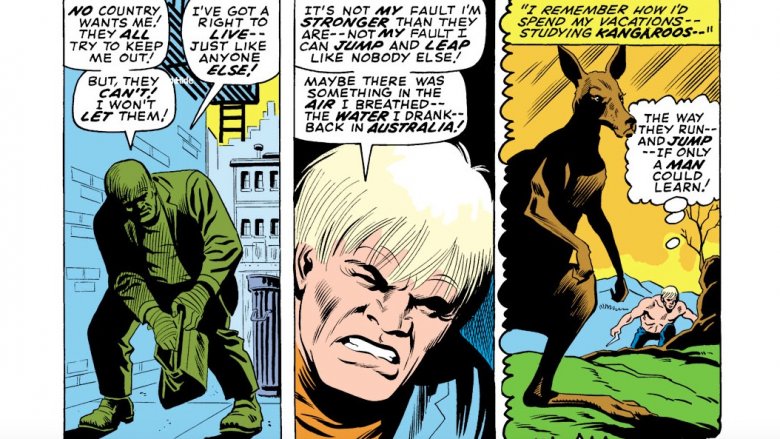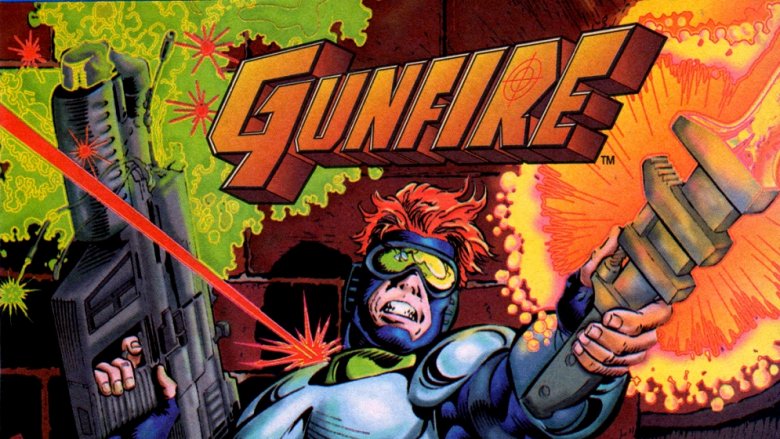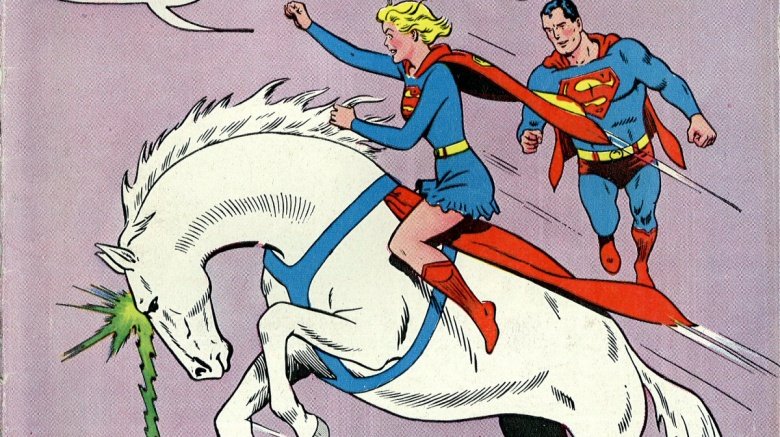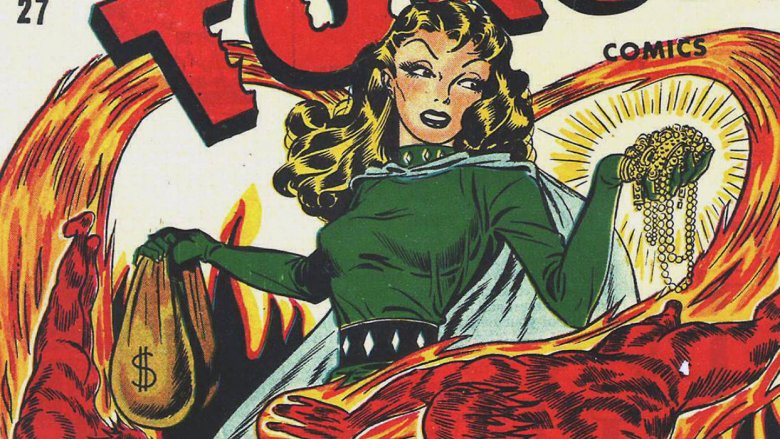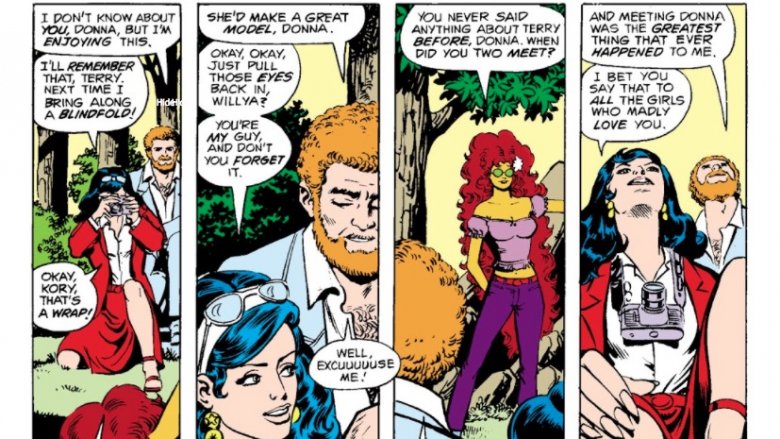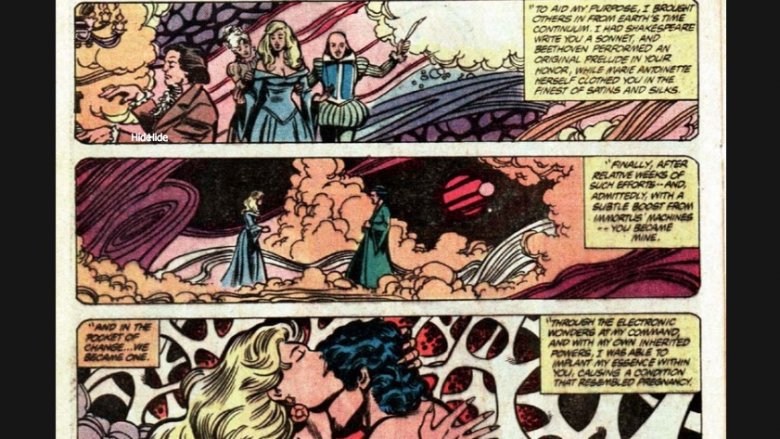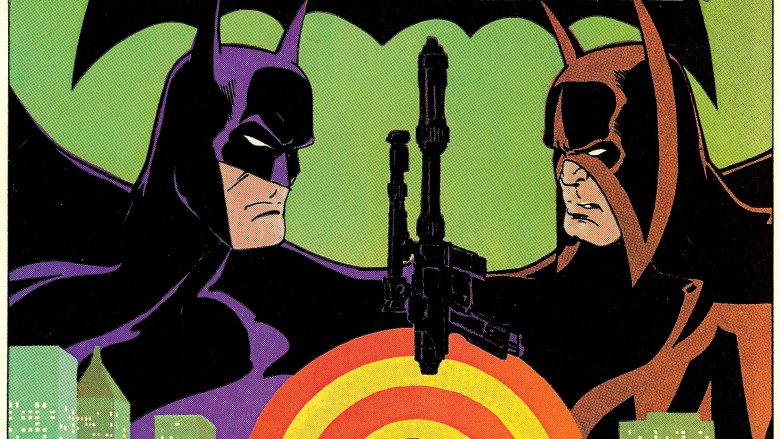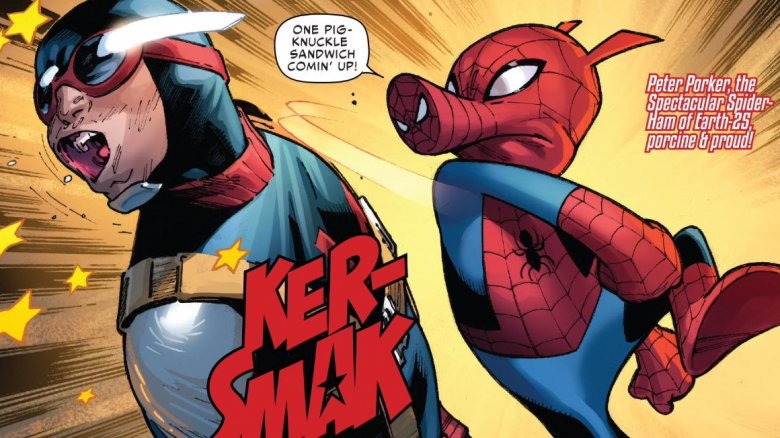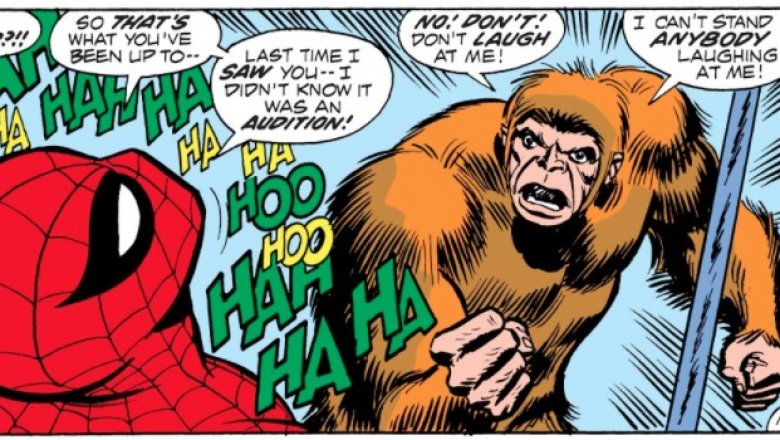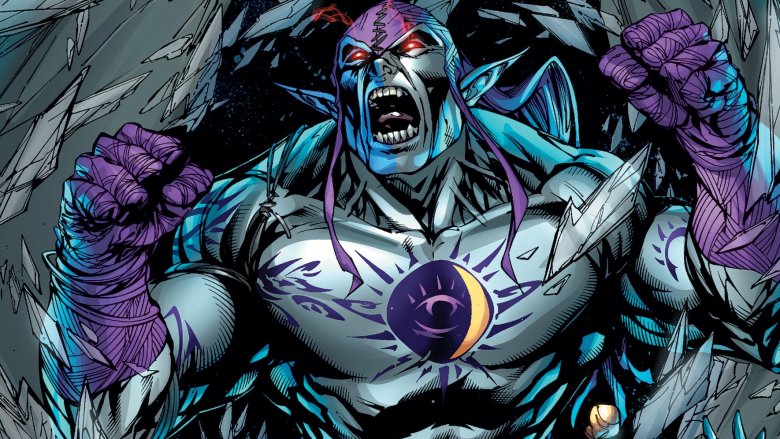Comics Characters That Should Never Be On Screen
Here at Looper, we love superhero movies. The synthesis of incredible actors with years of our favorite comics stories are simply too good to pass up. Part of the fun of these films is to see which favorite supporting players pop up. There are hundreds of great characters, thousands of good ones, and there are some that wouldn't, couldn't, and shouldn't ever make an appearance with our favorite heroes up on the big screen. Several of these characters are too bizarre to ever be re-created faithfully on screen, and a few are simply too awful for anyone to want them there...
The Kangaroo
It's hard to tell if The Kangaroo, an Australian who moved, fought, and was slightly dumber than a Kangaroo is offensive toward Australians or just offensive to the concept of good characters in general. Created by Stan Lee, Steve Buscema, Jim Mooney, and John Romita Sr., Frank Oliver was an Australian who lived with kangaroos for so long that he developed super-human jumping ability. Unfortunately, even among kangaroos, he was extraordinarily stupid, fleeing to America after accidentally kicking a man to death in a boxing match, forgetting his passport, and stealing—and then immediately losing—a massively deadly strain of bacteria in a fight against Spider-Man.
While Spider-Man's always had a long list of lovable losers that round out his rogues gallery, The Kangaroo has nothing to offer beyond a satisfying continuation of zoological villains that get webbed to the street lights of Marvel Comics' New York City. His interactions with Spider-Man are less fantastic fisticuffs and more your drunk friend who keeps trying to fight the guy at the end of the bar and never remembers his wallet. Some characters benefit from a fresh coat of paint and an exciting new take, but The Kangaroo is best left out in the Australian outback where he was found.
Gunfire
The '90s were a rough time for character design in comics: bad-boy anti-heroes who loved stabbing and shooting were in vogue, while compelling character designs and backstories were not. DC's Bloodlines crossover, in which aliens attacked random people and turned lucky ones into superheroes, introduced the world to arguably one of the worst of the pack: Gunfire, the man who can turn anything into a weapon. Created by Len Wein and Steve Erwin in Deathstroke Annual #2, Andrew Van Horn is part Iron Man, part Deathstroke the Terminator—minus anything compelling about either character.
Gunfire was given the power to turn anything with a point (think pipes, sticks, etc.) into an energy gun and anything round into a grenade. As exciting as it might be for a superhero to be given the same powers that every sugared-up elementary schooler that's watched too many Arnold Schwarzenegger movies wishes they had, Gunfire ended up firing blanks.
After the Bloodlines crossover, Gunfire dedicated himself to destroying the terrorist cells benefiting from his family's weapon productions (there's the Iron Man for you) and mostly appeared as an easter egg for attentive fans in the backgrounds of huge crossover events. When a character's best-known appearance is accidentally turning his butt into a grenade by accident (in Hitman: One Million), it's safe to say the character's not really meant for a big league movie adaptation.
Comet The Super-Horse
The Silver Age of DC Comics is known for ridiculous Superman stories with byzantine twists and combinations, but Comet The Super-Horse might take the cake, even within a packed bakery. Created by Jerry Siegel and Curt Swan in Adventure Comics #293, Comet was Supergirl's telepathic horse who's immune to Kryptonite. Pretty simple so far, right? Take a beloved female character and give her a super-powered pet that many young girls want, and you've got a great combo—in theory. Unfortunately, it gets worse.
It turns out Comet the Super-Horse was actually Biron, a centaur from Hercules' time who was accidentally turned into a horse by the magic witch Circe, then given a bunch of magic powers to make up for the raw deal, and then trapped in space by an evil wizard for thousands of years until Supergirl broke his prison by accident. You might be thinking that that's not so bad for a Silver Age comic, but it gets worse still.
In addition to all that, Comet also had a secret identity he transformed into when a magic comet would pass by—a cowboy (as in a man who rides horses for a living) who even dated Supergirl. Using his intimate knowledge of Supergirl, Biron was able to act on the secret love he'd always had for her as her pet horse. Yeesh. It's hard to imagine anyone getting excited to see that mess of an origin story on the big screen.
Asbestos Lady
If a man were, hypothetically, able to control flame and cover himself in fire like some sort of... "Human Torch," what kind of villain would he fight? Hydro-Man? Water Woman? Fire Extinguisher Lad? No, don't be stupid. Obviously the only villain that could possibly stop The Human Torch, the man who controls fire at will, is Asbestos Lady, named after that spindly insulation in older houses that gave people lung cancer.
Asbestos Lady, created by Mike Sekowski in Human Torch Comics #27, was the arch-nemesis of the original Human Torch (an android that could set itself on fire, not the Fantastic Four member) in '40s Marvel comics. Her gimmick was that she wore a special asbestos-lined suit that allowed her to safely start fires in banks to distract the police. While she and the Human Torch battled for years, she eventually found out that her asbestos-based strategies weren't as safe as she considered—she died of cancer from asbestos poisoning, a grim ending for any villain.
Terry Long
There's the gold standard of romantic relationships in the DC Universe with Superman and Lois Lane, and then, way down at the exact other end of the spectrum is Donna Troy and Terry Long. Created by Marv Wolfman and George Perez in Teen Titans #8, Terry Long is a divorced college professor who ends up dating, and eventually marrying, student Wonder Girl, Donna Troy (who, by the way, is a full decade his junior). Even while dating Donna, he's constantly flirting with other girls and wearing some of the worst shirts in comic books.
Rumors have persisted that Terry Long is actually a wish fulfillment character for writer Marv Wolfman (they did bear a resemblance at the time), which really only makes the character even more gross.
It's hard to imagine any actor charismatic enough to pull off the Molotov cocktail of red flags that is Terry Long. Luckily, Donna Troy's superhero history is complicated enough without adding in a creepy divorced mythology professor, so we can thankfully expect to never see this guy in movies.
Marcus
Speaking of questionable sexual politics in '80s comics, we have Marcus. Created by Jim Shooter, David Michelinie, George Perez (yes, the same Perez who created Terry Long), and Bob Layton in Avengers #200, Marcus is kind of like if a sexual predator and a living time paradox were combined.
Marcus is the son of Immortus, a time-traveling super-villain (who is also Kang, but older, even though Kang is also a time-traveling super-villain), who's been trapped in limbo for however you measure time in a timeless void. In order to escape, Marcus abducts Carol Danvers (Ms. Marvel at the time, although currently Captain Marvel), implants her with his seed after manipulating her into loving him, and then sends her back to her world. Ms. Marvel immediately becomes pregnant and gives birth within a few days to a son, Marcus. Basically, by impregnating Ms. Marvel, Marcus was able to escape Limbo, at least until time reverberations force him to return to Limbo.
There's a whole lot wrong with the above paragraph that's not even getting into how weirdly proud the rest of the Avengers are for Ms. Marvel to give birth to her own rapist, but, thankfully, the story's been so derided in recent years that it's unlikely we'll see a Marcus cameo in the upcoming Captain Marvel movie.
Wrath
We can probably agree that Batman is a pretty great character, right? The obsessive training, the great costume, the wish-fulfillment of a person capable of learning any skill through practice, hard work, and talent. It's no wonder then that so many Batman writers want to create a villainous mirror of those qualities. Unfortunately, while it's a great idea in concept, there're a bit too many anti-Batman types in comics these days, and way down at the bottom of the barrel is Wrath, created by Mike W. Barr and Michael Golden in Batman Special #1.
Dedicating himself to the destruction of law enforcement following the deaths of his criminal parents at the hands of Jim Gordon, The Wrath is basically Batman, but for criminals. That could have be great! Except that his origin—his parents killed by a policeman—becomes more compelling when it's used by evildoers Prometheus or Owlman. His willingness to kill and the assassin training are pretty interesting too but not as interesting as Batman villains Red Hood or Bane. Wrath's apparent knowledge of Batman's secret identity is a nice addition, but not quite as good as when it's used by rogues gallery stalwarts Ra's Al Ghul, Hugo Strange, or even Hush.
Unfortunately for Wrath, his gimmick is just better used elsewhere among the Batman rogues. Add in the bizarre attempt to mirror Batman's pointy ears by wearing a giant W on his face, and it's hard to imagine any moviegoers not bursting out laughing when they see him.
Spider-Ham
Spider-Ham is a parody of Spider-Man created by Tom DeFalco and Mark Armstrong in Marvel Tails #1. While at first glance he seems like a pretty obvious pun joke (man sounds like ham, you see), he's actually way more complicated than he seems. Peter Porker is actually a spider that was bitten by a radioactive pig (who is also that universe's Aunt May) and transformed into a pig in a world of anthropomorphic animals. He decides to fight crime as Spider-Ham. Most of his villains are pretty easy to guess: Duckter Doom (Doctor Doom), The King-Pig (The Kingpin), and Doctor Octopussy Cat (Doctor Octopus, who, for some reason, is not an octopus).
There's nothing inherently wrong with the character, especially since the comics are surprisingly funny for how immediately apparent the joke is, but it's just hard to imagine a world in which any audience is receptive to Spider-Ham. The Marvel movies might venture into some goofy comics territory, but they're still more serious than "an entire world of talking animals"-level goofy.
The Gibbon
While we're on the subject of anthropomorphic animal superheroes in the Marvel universe, The Gibbon has a doozy of a publication history. Created by Stan Lee and John Romita Sr. (making their second appearance on this list) in the Amazing Spider-Man #110, Martin Blank is a man who appears to have the mutant power to look and act like a gibbon. A pretty easy-going guy, he decides to dedicate himself to helping the world with his hero, Spider-Man.
Unfortunately, in another example in a long line of Peter Parker making problems for himself, he laughs at Blank, mocking his dreams, and driving him into a potion-enhanced rampage. Blank eventually recovers and becomes a recurring villain and occasional hero, never really succeeding at either.
Ultimately, the Gibbon's just too much of a bummer to really show up on the big screen—his entire publication history is basically the comic equivalent of the Old Gil joke from The Simpsons. Well, except for that time he was pulled into "Simian-World" to team up with the Ape-Vengers in order to fight a scourge of vampires from taking over the world. Although, we're pretty sure we won't be seeing that particular adaptation on the big screen any time soon.
Eclipso
Bruce Gordon, aka Eclipso, created by Bob Haney and Lee Elias in House of Secrets #61, is like an office joke that got out of hand and got printed into an actual comic by accident. First, we've got his name, Bruce Gordon, which is literally just a portmanteau of Bruce Wayne and Jim Gordon. That's one of the weakest secret identity names we've seen since Roy G. Bivilo was the real name of the Rainbow Rider.
His actual appearance as a supervillain is spurred by eclipses, following an attack by a sorcerer in the jungle that basically turned him into a purple Mr. Hyde-type of monstrous id. Eclipso's personality was so cookie cutter it was sold at bulk at the dollar store, with the requisite grab bag of superpowers like super strength and laser eyes. A later retcon turned him into a former iteration of The Spectre, DC's literal Vengeance of God symbolized by a superhero with a green cloak. Comics are weird.
Either way, there's not really a version of Eclipso that could work on screen—the original is a character so boring they didn't bother to come up with an original name, and the newer retcon brings up more uncomfortable theological questions than most moviegoers would likely not be prepared to answer.
